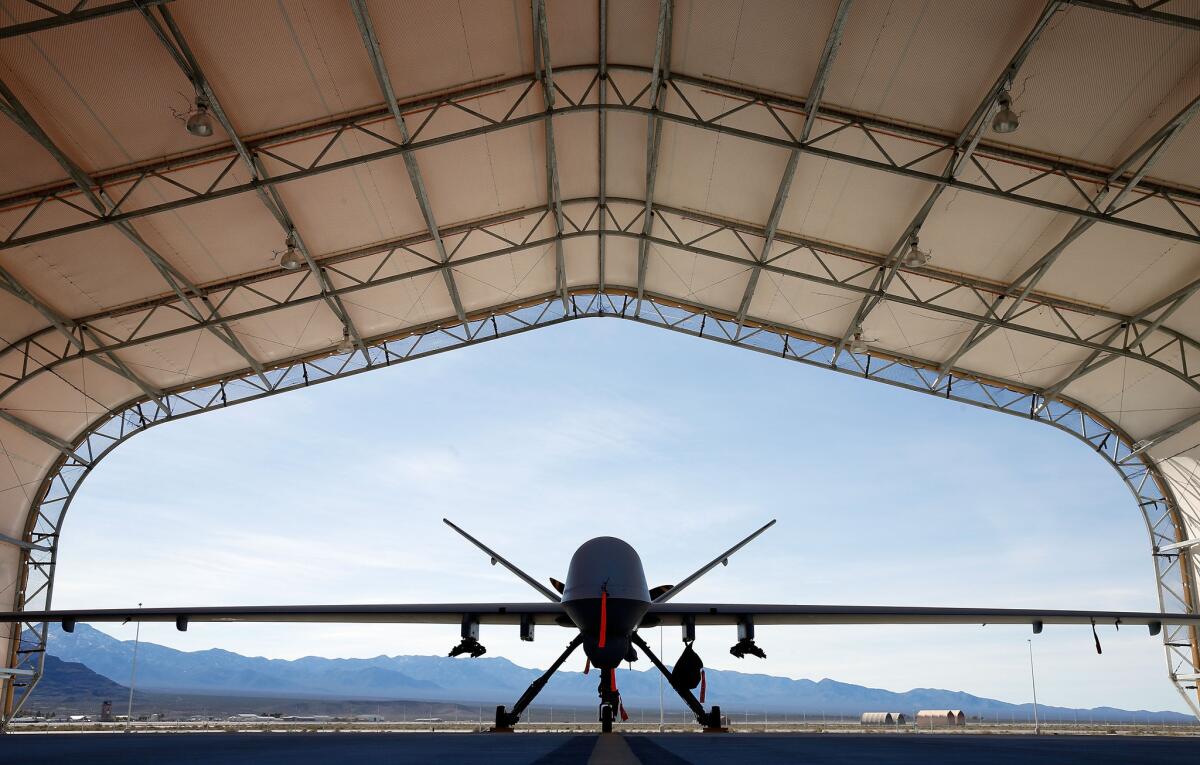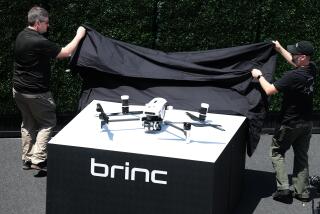Air Force to allow non-officers to fly drones for first time

An MQ-9 Reaper remotely piloted aircraft is parked in an aircraft shelter at Creech Air Force Base in Indian Springs, Nevada. Enlisted Air Force personnel will be allowed to become drone pilots, according to a new policy.
Reporting from Manama, Bahrain — The Air Force will allow enlisted personnel to become drone pilots for the first time to help meet demands for increased surveillance over global hot spots, according to a new policy announced Thursday.
The decision, which follows months of study, is the latest Air Force effort to overhaul the growing drone program, which has struggled to recruit and retain enough officers to serve as drone pilots.
Counter-terrorism operations including the battle against Islamic State have created constant demand for aerial intelligence, surveillance and reconnaissance, or ISR. Drone pilots say they are overworked and badly stressed.
Join the conversation on Facebook >>
“This group of people have been front and center of the war effort for the past 15 years,” Air Force Secretary Deborah Lee James said in a recent interview. “If you talk to combatant commanders around the world, which I do regularly, and ask them, ‘What is the one more thing you need from the Air Force?,’ they will always reply, ‘I want more ISR.’”
Under the new policy, qualified enlisted personnel will be allowed to pilot the unarmed RQ-4 Global Hawk spy drone. They may eventually be permitted to operate the missile-firing MQ-1 Predator and MQ-9 Reaper drones.
“We’re going to take it one step at a time, and step one will be Global Hawk,” James said.
The Army Air Corps, predecessor to the Air Force, allowed enlisted airmen to pilot warplanes during World War II. But only officers could become pilots in more recent years, even for drones.
In fiscal year 2014, the most recent data available, the Air Force trained 180 drone pilots, and 240 veterans left the field.
James has directed Air Combat Command, which oversees drone operations, to develop a plan over the next six months to clear the way for non-officers to serve as drone pilots by next year. The study will address entry requirements, training, career path development and compensation.
The Air Force will start with Global Hawk because the high-flying jet is easier to operate. It is largely flown autonomously via computer control rather than a joystick like the Predator and Reaper.
“Remotely piloted aircraft that require more monitoring than actual hands on, such as the Global Hawk, should be considered as viable for operation by enlisted personnel,” said retired Air Force Gen. David A. Deptula, who was deputy chief of staff for intelligence, surveillance and reconnaissance.
The Global Hawk also has a more stable training program than the Predator and Reaper. Those programs are backlogged because the Air Force lacks experienced pilots as teachers.
NEWSLETTER: Get the day’s top headlines from Times Editor Davan Maharaj >>
Global Hawk pilots train at Beale Air Force Base, about 40 miles north of Sacramento. It’s home to high-altitude spy planes, and its motto is emblazoned on signs that read, “In God We Trust. All Others We Monitor.”
Drone pilots already complain that they are held in lower regard than traditional fighter pilots, and that allowing enlisted airmen in will only increase the stigma.
But James expressed confidence that they, and the rest of the Air Force, will adapt.
“We have great confidence in our enlisted force that they can do this job,” she said. “Times change and we learn, and we talk about strategic agility, so we have to be prepared to try new things.”
Follow @wjhenn for military and defense info.
ALSO
Congress sends President Obama massive year-end tax cuts and spending package
Obama will travel to San Bernardino to mourn victims of massacre
Climate change activists are just warming up
More to Read
Sign up for Essential California
The most important California stories and recommendations in your inbox every morning.
You may occasionally receive promotional content from the Los Angeles Times.











